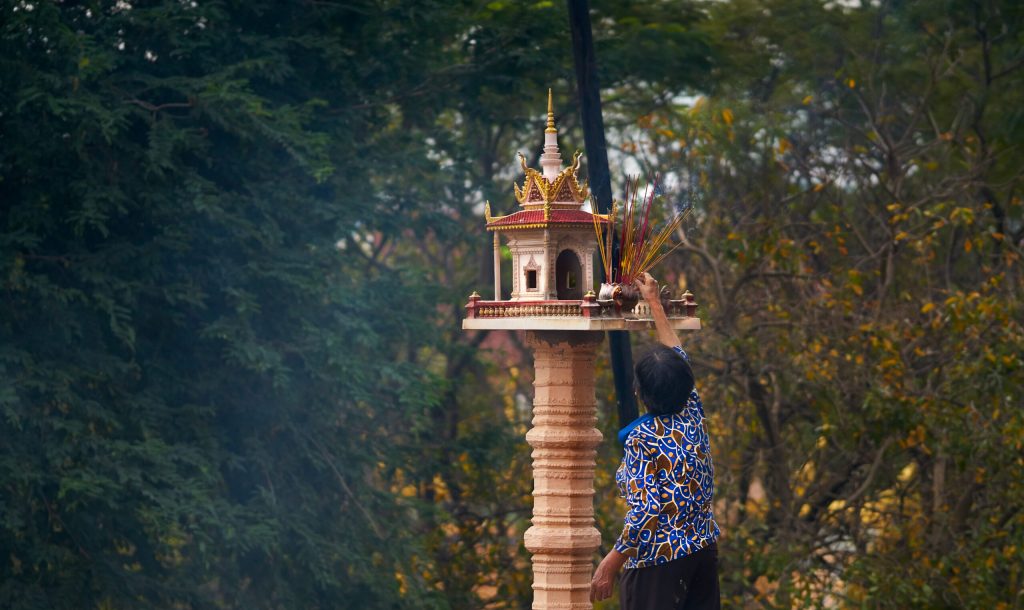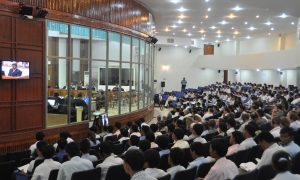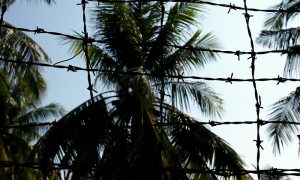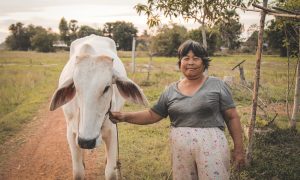The way by which human beings relate to the environment is of urgent relevance today. The accelerating rate of environmental devastation in recent decades has gone hand-in-hand with the global triumph of a particular civilisational logic—consumerism. Anthropologists have long been interested in documenting ways of life practised by peoples who retain some autonomy from consumerist logic. Unlike the consumerist relationship to the environment, many cultural systems have traditionally regarded special features of the natural world as subjects possessed of powers that command respect. These ways of interacting with the world around us are not simply exotica or collections of superstitions. They contain profound lessons about the way humans can relate to the natural environment and we ignore them at our peril.
As Baudrillard wrote in his work The System of Objects, ‘… consumption is an active form of relationship (not only to objects, but also to society and to the world), a mode of systematic activity and global response which founds our entire cultural system’. The logic of consumerism is depriving the planet of subjectivity in human perception and casting it instead as an object of human domination and source of resources, which mankind enjoys the right to extract.
As delicate ecological systems and vulnerable cultural systems become subsumed by consumerist forces, their resilience and chances of recovering seem to be increasingly remote. I describe here several examples from Cambodia which show how capitalist forces have induced traditional spirits of the land to desert and be deserted by people. These have been selected to illustrate how a culture of consumerism is destroying the ability of both communities and their environments to resist and, perhaps, ever recover from the destruction wrought by unchecked consumerism.
While assaults on the environment have accompanied all modernisation initiatives in Cambodia, they gained momentum when Cambodia entered the global free market in the early 1990s. Although some 75% of Cambodians still rely on agriculture as a major part of their livelihoods, by 2012, the Cambodian state had granted around 2 million hectares of land as concessions to private corporations to create monoculture plantations, extract minerals, log hardwood and construct hydro-electric dams. To make way for this flood tide of so-called development, communities that traditionally respected the spirits of the land have been displaced from areas their forebears inhabited for generations. Communities, spirits and forests are disappearing as the new, consumerist way of relating to the land literally gains ground.
Khmer Buddhism and the neak ta
When Theravada Buddhism spread throughout Cambodia in the 13th century, it subsumed but did not eclipse pre-existing spirit worshipping practices. Despite the cultural divergence between the lowland Khmer majority and highland minority groups, they continued sharing a concern for the spirits controlling the resources on which they depended. In this cosmological system, the power of the source of all life—generally known as the maja tuk maja day (literally owner of the water and land)—manifested in specific forms, such as rivers, mountains, trees, rocks, great ancient trees, peculiarly shaped rock formations, termite stacks, wooden linga and more. The term neak ta (or lok ta) is used to refer to these spirit forms. A neak ta may appear in the form of phenomena such as tutelary spirits that protect specific communities, or as human ancestors and deceased heroes.
Often, a neak ta relates to the establishment of a specific settlement and is, in this sense, foundational. Some neak ta take anthropomorphic form and arise within a historical narrative. Stories abound of how ancient heroes protected the integrity of the Khmer realms while alive, and continued to do so as spirits after their deaths. Particularly in urban settings—for example, outside courtrooms or alongside major roads—one may find humanoid statues of historical figures such as Neak Ta Kor Krohom. This figure appears all over the country, woven into local legends of a deceased powerful figure.
These spirits articulate a variety of relationships: relations between people within the community, relations between the living and the dead, and relations between people and the environment—particularly when it comes to resource utilisation. Traditionally, when treated with respect, the neak ta responded by protecting and providing for communities and their members. However, when neglected or when the environment they ‘owned’ was transgressed, they could respond in wrath, striking people down with illness, flooding or depriving communities of rainfall and therefore food, withholding game animals during hunts, causing accidents, sterility and all manner of misfortune.
Historically, the ideal Khmer Buddhist sovereign was supposed to be possessed of virtuous power known by the Buddhist term parami. He achieved this by practising the ten kingly Buddhist virtues known as desarajadhamma. Many Cambodians in their forties and older, having grown up without television or even electricity, recall hearing their parents tell allegorical tales of the relationship between the ruler’s virtue and the welfare of both the human and non-human realms. One man in his forties told me that when criticising the current regime, he and his friends may refer to a story of an ancient ruler King Senakak Reach (the ‘Gangster King’), who took the throne illegitimately, then ruled with greed and cruelty. The King’s immoral behaviour enraged not only the people, but also the spirits. As punishment for the King’s misdeeds, the waters flooded the lands, forcing the King to flee, drowning people and causing diseases to spread.
The idea that rulers who fail to exercise virtuous power in respecting and caring for the environment ultimately unleash environmental catastrophe remains salient today. Unlike the supremely virtuous powers associated with the Buddhist sovereign, the neak ta are susceptible to corruption and co-optation. They share many characteristics with living people and their existence depends on human succour. They may favour the increasingly generous rich over the poor who, in the predatory and competitive world of consumerism, have less and less to offer them. Many claim that the spirits are deserting rural people, and that Cambodian villagers are equally forsaking the spirits of the land by adopting the new ethic and joining the rush for consumption. Others say these spirits have been bribed and corrupted by the enormous wealth accumulated by the new Cambodian elites.
Breaking the spirits of the people and their land
When I asked forest dwelling people in Mondulkiri province where the spirits of the great trees go once the trees have been felled, they told me they move to another tree. But once all the trees have gone, they will abandon the area altogether. One medium explained that the spirits of the trees only have the power to affect those who are close to them. They may visit misfortune upon the man brandishing a chainsaw, but their powers do not extend to socially distant company directors, who remain cosseted in air-conditioned offices in the city.
The construction of the Lower Sesan 2 dam in Stung Treng is a case in point. The idea of constructing a hydro-electric dam on this river was mooted in 1999 by the Asian Development Bank. It was a typical example of a programme focused on energy production for national economic growth while ignoring local communities’ interests and relationships to the water and forests of the area. Many of these communities consisted of ethnic minorities who had particularly strong cultural attachments to the environment. By 2012, the project had fallen into the hands of private companies: China’s HydroLancang International, Cambodia’s Royal Group and Vietnam Electricity.
The dam was to be constructed on the Sesan River, a significant migration route and breeding ground for fish from the Mekong. When dam construction began in 2012, one study projected an almost 10% drop in fish stocks in the Lower Mekong Basin following the dam’s completion and the extinction of as many as 50 species. It was also predicted that the flood patterns of the Mekong River and Tonle Sap Lake would be radically altered.
The government paid no heed to scientific or international expertise. While dam construction works continued apace, desperate members of local communities, who stood to lose everything, beseeched their local neak ta for assistance. They recalled the power of their guardian spirit, who had successfully protected the village from US bombs during the 1970s. In 2010, when the villagers first learned of the plans to construct a dam, they implored the neak ta to intervene on their behalf. They offered to sacrifice three water buffalo within five years in exchange for his protection.
Despite these efforts, intensive deforestation and dam construction continued and neared completion by 2015. The ancient forest that had for generations provided locals with food, medicines and a resting place for the dead was already gone. When discussions were held that year about whether to sacrifice the promised buffalo, the elders decided that their neak ta had failed them and so the animals’ lives should be spared. One of the dam’s turbines became operational in 2017 and the entire construction officially opened in December 2018. The spirits of the people had been defeated, both literally and figuratively.
Beban and Work have described a similar case in Pursat Province. In this case, deforestation was being carried out in preparation for the development of a plantation. In 1997, the government had granted a 315,000-hectare Economic Land Concession to Pheapimex Corporation without the knowledge of the thousands of villagers living inside the area. Pheapimex is one of Cambodia’s most powerful companies, claiming ownership of some 7% of Cambodia’s land area. Its director, Lau Meng Khin, is a renowned senator in the ruling Cambodian People’s Party (CPP). He was also involved in the company Shukaku Inc., which evicted families living around Boeung Kak Lake in Phnom Penh and filled in the lake to create prime real estate land. He was similarly reputed to be the owner of the Alex Corporation, behind an ambitious mining project in Mondulkiri Province.
Lau Meng Khin illustrates the way Cambodia’s major companies are tightly knitted into Cambodia’s notorious political culture of personalised patron-client systems, with the prime minister at the apex of a network incorporating the military elite, police, judiciary and regional and local authorities. Given the endemic corruption in Cambodia’s institutions, the possibilities for poor communities to stand up against this kind of power network using secular institutions are extremely limited. Turning to the spirits for support may seem the only viable alternative.
In 2009, just as Pheapimex was beginning forest clearance in Pursat, a woman from the region suddenly became possessed by a spirit that demanded the machine operators stop clearing trees in front of the pagoda she was visiting. “This is our home, the mountain has been our home since ancient times,” the spirit said. “If you cut the trees we cannot stay.” 5,000 of the 315,000 hectares were then awarded to the temple, whose head monk had been visibly active in resistance to the plantation project. Although state actors alluded to the spirit’s importance, this was done in such a way as to authorise their grab of 310,000 hectares from local communities. Again, propagators of consumerist logic won and the locals, their forests, their spirits and the web of relations between them were defeated.
Corrupting the spirits
A third example comes from Preah Vihear Province, where Jonas Kramp conducted a study in 2017 concerning a conflict between ethnic Kui villagers and five Chinese concessionaire companies, all subsidiaries of the Hengfu Group Sugar Industry Company. The deforestation of large swathes of land and takeover of villagers’ farmland to plant sugarcane was leaving local farmers destitute. Oppression by local authorities was also making it difficult for the communities to organise themselves and act in solidarity. Activists gathered in smaller groups, setting up protest camps and, importantly, building a new spirit house to worship the neak ta of the area.
However, the villagers were disappointed to find that their neak ta did little to help. Not only were the neak ta powerless against the companies’ heavy machinery but they were also susceptible to bribes and greed. The villagers said the neak ta had changed sides. During a spirit ceremony, they asked their spirit why it had failed to help them. The response was that the Chinese companies had made more lavish offerings than the locals. One local compared this to his own nephew’s choice to sell up to the company and accept employment in it. Disloyalty to the moral order is mirrored between people and their spirits.
The only recourse left for the villagers in this case seemed to be to appeal to their spirits to curse the Chinese companies, the local authorities and people who sold out to the companies to ‘become homeless ghosts and to die for seven generations’. Recent developments suggest that perhaps this is having some material effect since in mid-2020, the Hengfu Sugar Company’s subsidiaries all had to cease operations indefinitely on account of numerous irregularities.
Desertion of the spirits
My final example comes from my own fieldwork. I have met several spirit mediums over the years whose stories have struck me as notably allegorical. The most recent was in 2020, when a man in his sixties living in Battambang Province explained that the spirits are abandoning local villagers there too. I shall call him Mr Chan.
Mr Chan explained that the neak ta which entered his body were once people who had exhibited extraordinary power in life—parami. Neak Ta Dambong Dek and Neak Ta Oung, the two spirits that had come to him, had been brave commanders. They had fought to protect the Khmer people from all forms of threat. But he added, “It’s different now. In the past Lok Ta was much stronger and people relied on his help. Nowadays, he is not as strong because people no longer respect him as much … Therefore, Lok Ta doesn’t like to stay here with the people but prefers to stay elsewhere, especially in Thailand because … [here] people always make problems with each other so the neak ta are not happy to stay with us”.
Among rural people in Cambodia, there has therefore long been an understanding that greed and unrestrained exploitation of the environment will incur reprisals. If we abandon the powers that rightfully own and protect the treasures of the water and land, they too will abandon us. This worldview dovetails now with that of climatologists and environmentalists worldwide who are regularly presenting evidence of the way that the planet is irrevocably succumbing to human plundering.
We need to pay heed to the lessons that may be gleaned from rapidly disappearing cultural schemes before it is too late. They provide invaluable insights about the way humanity relates to the environment, as well as the notions of development, progress and civilisation that are now driving the extinction of both cultural and bio-diversity. Clearly, we have a great deal to learn about our duties of reciprocity in relations with the powers of our environment.
I would like to extend warm thanks to the Swedish Research Council and the Bank of Sweden Tercentenary Foundation for the sponsorship that enabled me to undertake the research underlying this article. Thanks are also due to Dr Courtney Work for much inspiration in developing these ideas. And sincere gratitude also to all the Cambodians who have helped me understand what is happening to their country and, by extension, to our shared world.
 Facebook
Facebook  Twitter
Twitter  Soundcloud
Soundcloud  Youtube
Youtube  Rss
Rss 


